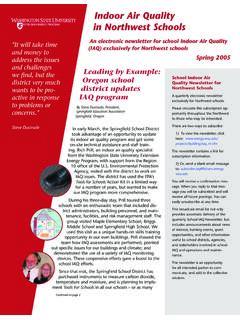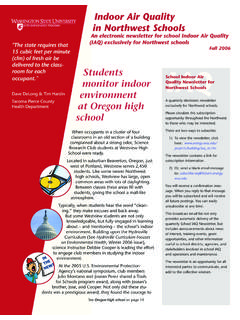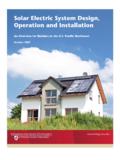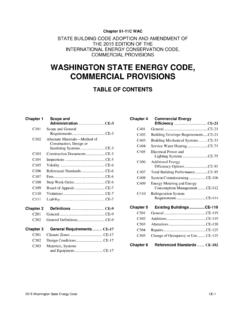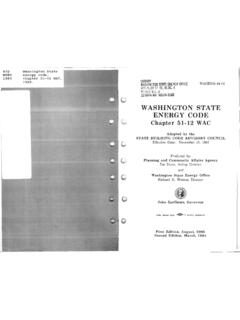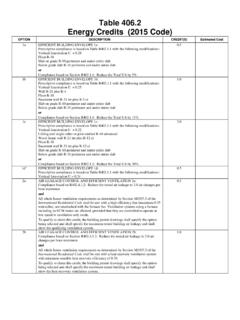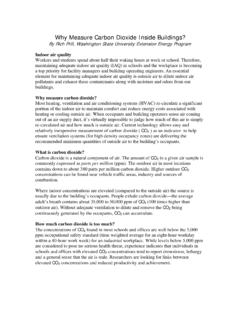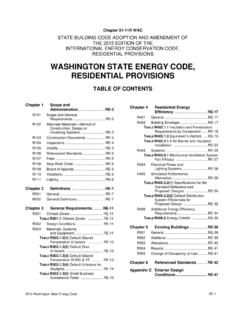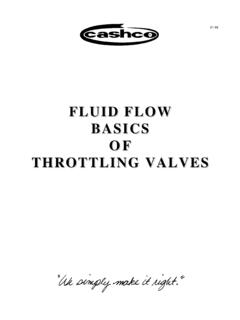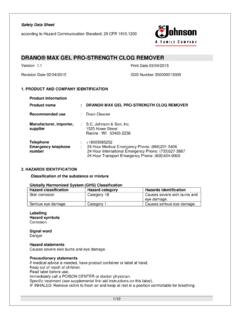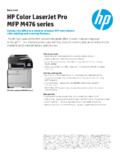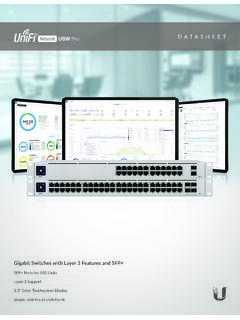Transcription of Ground-Source Variable Refrigerant Flow Heat Pumps
1 Energy Efficiency Factsheet: Ground-Source Variable Refrigerant Flow heat Pumps Page 1 Ground-Source Variable Refrigerant Flow heat Pumps :A Solution for Affordable Housing, Assisted Living, Hotels and DormsBy Marcia Karr, Energy Engineer, Washington State University Extension Energy ProgramIn recent years, the decreasing costs and increasing quality of Variable Refrigerant flow (VRF) equipment have led to efficiencies comparable to and even exceed-ing the efficiency of standard Ground-Source heat pump (GSHP) systems. Because of this, the cost-effectiveness of installing Ground-Source heating, ventilating, and air conditioning (HVAC) systems has been called into question. The advantages of GSHPs (sometimes called geothermal heat Pumps ) are that they tap a large reservoir of nearly constant-temperature heat (the ground ) and they use water as the heat -exchange fluid, which is more efficient than using air. However, VRF technology, even with air-to-air heat exchangers, can meet or exceed the efficiencies of GSHPs by using multi-speed fans and Variable speed compressors.
2 In addition, VRF technology enables recovery of heat or cooling from one zone to use in other zones (in buildings where some zones are in heating mode while others are in cooling mode).A Ground-Source VRF heat pump system combines the advantages of both technologies into one system, making it one of the most efficient HVAC systems available for many applications. By using ground water loops, multi-speed fans and Variable speed compres-sors, Ground-Source VRF heat pump systems achieve savings over either GSHP or VRF on their is a Ground-Source heat Pump? A typical heat pump heating and cooling system is called an air-to-air heat pump because it exchanges heat with outside air in order to provide heating or cooling. These heat Pumps are rated based on American Heating and Refrigeration Institute (AHRI) standards. AHRI tests equip-ment under identical laboratory conditions to determine its rating. This rating allows for apples-to-apples comparisons of efficiency among different manufacturers.
3 It turns out, however, that the performance of air-to-air systems in real world conditions, where the equipment is exposed to very hot and very cold conditions, is often inferior to performance in lab conditions. To compensate for decreased performance in extreme conditions, equipment is often specified to be over-sized. If ambient conditions were more moderate and more predictable, this over-sizing would not be way to achieve relatively constant ambient conditions is to bury pipes underground, where the temperature is relatively con-stant year round. Because heat is exchanged with the ground rather than the outside air, GSHPs remain Energy Efficiency Factsheet: Ground-Source Variable Refrigerant Flow heat Pumps Page 2a very efficient source of heating and cooling all year. The GSHPs typically use the refrigerants R-22 or R410A, which are well-suited to efficiently draw heat from or reject heat to water in this temperature range.
4 Because water transfers heat much more efficiently than air, the system gains additional efficiency by using water as the heat exchange piping system can be install-ed in one of four common configurations: Closed loop systems, which consist of three configurations: slinky or straight horizontal trenches (Figure 1), vertical wells (Figure 2) and pond/lake source (Figure 3). Open loop system, which requires an underground well (Figure 4).Figure 1. Horizontal trenches Figure 2. Vertical wellsFigure 3. Pond source Figure 4. Open wellEnergy Efficiency Factsheet: Ground-Source Variable Refrigerant Flow heat Pumps Page 3 Things to consider:1. Pipe length depends on a number of factors, but for estimating purposes a rule of thumb is about 400 lineal feet per 400 square feet of building. The slinky design shown in Figure 1 requires an area for trenches that is about twice the area of the Construction hygiene is critical.
5 The piping must be protected from dirt, critters and other sources of The horizontal piping should be 5-10 feet deep, depending on frost level. The deeper the pipe, the more stable the tempera-ture; the more stable the temperature, the more efficient the system. 4. heat pump systems can provide pre-heating for potable hot water with a desuperheater when the heat pump is in cooling is Variable Refrigerant Flow?VRF equipment has the follow-ing features that make it a very efficient HVAC system: Multi-speed fans on the indoor and outdoor units rather than single-speed fans. Linear expansion valve rather than open/close. Variable speed compressor. Internal/external heat recovery between zones. heat rejected from one zone can be used in another part of the building rather than being rejected to the outside. Minimal losses from ducts since most or all of the ductwork is eliminated. Eliminating ducts may also allow buildings to be designed with lower floor-to-floor heights, reducing construction features, as shown in Figure 5, make VRF more efficient than most other HVAC and water heating technologies in many applications.
6 The American Society of Heating, Refrigerating and Air Conditioning Engineers (ASHRAE) and AHRI have developed a new efficiency test standard Standard 1230 to capture these features. The new standard is the Integrated Energy Efficiency Ratio (IEER), which was developed to more accurately reflect the efficiency of VRF systems. As shown on slide 4 in this ICF International presenta-tion on EER and IEER Ratings in HVAC Program Implementation ( ), the energy efficiency ratio (EER) is described as not so good at indicating energy (kWh) savings potential. As noted on slide 5, IEER may be a better indicator of energy usage. VRF systems have heat exchanger units located outdoors that are connected to one or more indoor units. In some conditions, one or more units may be in heating mode at the same time that others are in cooling mode. This feature allows heat rejected from rooms that are in cooling mode to be used by other rooms that are in heating BenefitsSome of the benefits of VRF systems are: Energy savings due to better part-load efficiencies and reducing or eliminat-ing duct losses, when compared to standard air-to-air heat Pumps .
7 Smaller mechanical space requirements, both interior Figure 5. A typical VRF applicationEnergy Efficiency Factsheet: Ground-Source Variable Refrigerant Flow heat Pumps Page 4 Figure market share in various marketsand exterior. Design flexibility with the variety of indoor air handler options. Easier retrofits where running ductwork is an issue, such as an older building that lacks duct-work or where the current ductwork is undersized. In retrofit applications, existing ductwork can be used for ventilation air. Greater rentable space due to smaller mechanical rooms. Lower construction costs due to less space required between floors for duct-work. Relatively lighter weight, minimizing structural VRF technology is not new; in fact, it is the technology of choice in Japan, China and Europe, as depicted in Figure term ductless in this chart is synonymous with VRF. However, VRF now includes many styles of equipment, including wall-mounted ductless, above ceiling ducted, cassettes, floor mount and Are Potential Energy Savings of a Ground-Source VRF heat Pump System?
8 To compare the energy use of various HVAC systems, a 25,000 square foot single-story assisted living building was modeled for 10 cities using using Energy Pro build-ing modeling software. The energy used per system type and per city is noted in Figure 7 and Table 1 (see next page).The modeling software algorithms have resulted in conservative energy savings. Using Energy Star s Portfolio Manager ( ), many VRF buildings have come in with energy use index (EUI) better than the model Ground-Source VRF heat Pumps in the Real World The Little Deschutes Lodge ( ), an affordable housing project for seniors in La Pine, Oregon, has a Ground-Source VRF heat pump system and the facility is nearly Figure 7. Percent theoretical savings over air-source heat pumpFigure 7. Percent theoretical savings over air-source heat pumpGround-Source VRF Savings vs. HP VRF Savings vs. HP GSHP Savings vs. HP Japan90% SystemsChina86% SystemsEurope81% SystemsUSA3% SystemsDuctless is a small percent of the HVAC market but current building and energy usage trends indicate a large growth 10% 20% 30% 40% 50%PortlandSeattleKansas CityDallasLincolnFargoSalt LakeDenverPhoenixBillingsEnergy Efficiency Factsheet: Ground-Source Variable Refrigerant Flow heat Pumps Page 5net-zero energy.
9 Little Deschutes Lodge is a 26-unit complex with on-site laundry, a community room, a reading room, and two computer centers. Even with these amenities and features, the total gas and electric bills for the facility, divided by the number of apart-ments and by 12 months per year, came to only about $37 per month per apartment! Little Deschutes Lodge s site EUI is only 29 kBtu/square foot/year, compared to about 70 kBtu/square foot/year for an average dorm unit as calculated using Energy Star s Portfolio Man-ager. This project has a Portfolio Manager score of 95, modeled as a dorm, which means that it is more efficient than 95 percent of other similar units. The Little Deschutes Lodge design from SOLARC Architecture and Table 1. Annual energy use (kBtu/sf/yr) and percent savings compared to air-source heat pumpCityAir-Source heat Pump (HP)1 Ground-Source HP2 VRF (air-source) Ground-Source VRF HP kBtukBtu% SavingskBtu% SavingskBtu% Energy Use & EER = , Seasonal Energy Efficiency Ratio (SEER) = , Heating Season Performance Factor (HSPF) = Air-source heat Pumps are commonly used in assisted living facilities, hotels, EER = , Coefficient of Performance (COP) = , Inc.
10 In Portland, Oregon ( ), includes the following components: 28 horizontal trenches, each approximately 150 feet long. Header piping at 6 foot depth, trench piping at 9 foot maximum depth. 600 feet of 1-inch pipe per trench, with four pipes spaced evenly in a 3-foot-wide trench. Trenches spaced 12 feet on center. Overall area of the piping field is approximately 50,000 square feet. Four heat Pumps (Mit-subishi City-Multi PQRY P96 TGMU, 8 tons each) serve the apartments, office, reading and fitness rooms. One Florida heat Pump (ES-070, tons) serves the community room and Deschutes LodgeEnergy Efficiency Factsheet: Ground-Source Variable Refrigerant Flow heat Pumps Page 6 One 300 cfm energy recovery ventilator serves the community room and kitchen, and one 800 cfm unit serves the rest of the building. Ducted units in apartments, ductless in common spaces. A desuperheater is used for preheating hot water. The solar thermal system is thermally connected to the ground loop to take advantage of solar energy when Efficiency and Minimizing MaintenanceFor affordable housing to be viable, operating and maintenance costs need to be as low as possible so property owners can hedge against rising utility costs and rising operating and maintenance costs.
